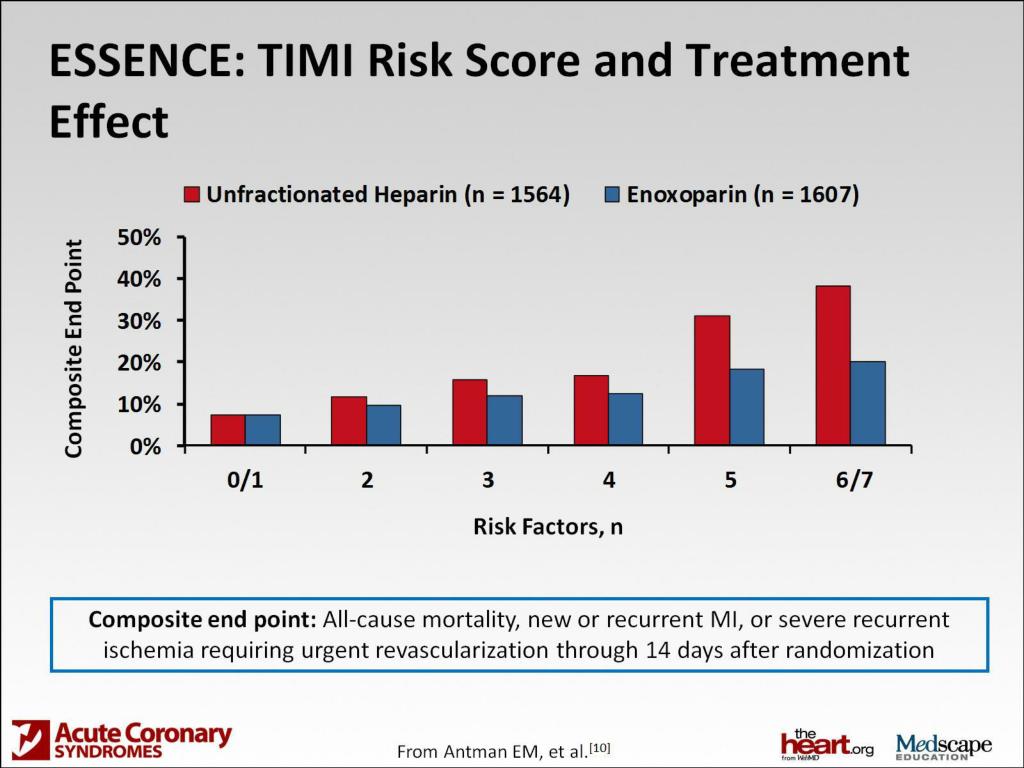
In patients with UA/NSTEMI, the TIMI risk score is a simple prognostication scheme that categorizes a patient's risk of death and ischemic events and provides a basis for therapeutic decision making. The slope of the increase in event rates with increasing numbers of risk factors was significantly lower in the enoxaparin groups in both TIMI 11B (P =.01) and ESSENCE (P =.03) and there was a significant interaction between TIMI risk score and treatment (P =. The pattern of increasing event rates with increasing TIMI risk score was confirmed in all 3 validation groups (P<.001). This study is the first of its kind in a population in Pakistan.

Hence, this study was conducted to assess the validity of the TIMI risk score for predicting 14-day mortality in NSTEMI patients in Pakistan. Event rates increased significantly as the TIMI risk score increased in the test cohort in TIMI 11B: 4.7% for a score of 0/1 8.3% for 2 13. Hence, risk stratification modalities, such as the TIMI risk score, were found to be useful in stratification of high-risk patients. The 7 TIMI risk score predictor variables were age 65 years or older, at least 3 risk factors for coronary artery disease, prior coronary stenosis of 50% or more, ST-segment deviation on electrocardiogram at presentation, at least 2 anginal events in prior 24 hours, use of aspirin in prior 7 days, and elevated serum cardiac markers. Outcomes were TIMI risk score for developing at least 1 component of the primary end point (all-cause mortality, new or recurrent MI, or severe recurrent ischemia requiring urgent revascularization) through 14 days after randomization. Relative differences in response to therapeutic interventions were determined by comparing the slopes of the rates of events with increasing score in treatment groups and by testing for an interaction between risk score and treatment. The TIMI risk score was derived in the test cohort by selection of independent prognostic variables using multivariate logistic regression, assignment of value of 1 when a factor was present and 0 when it was absent, and summing the number of factors present to categorize patients into risk strata. The 3 validation cohorts were the unfractionated heparin group from ESSENCE and both enoxaparin groups.

The pattern of increasing event rates with increasing TIMI risk score was confirmed in all 3 validation groups (P.001). A total of 1957 patients with UA/NSTEMI were assigned to receive unfractionated heparin (test cohort) and 1953 to receive enoxaparin in TIMI 11B 15 were assigned respectively in ESSENCE. rates increased significantly as the TIMI risk score increased in the test cohort in TIMI 11B: 4.7 for a score of 0/1 8.3 for 2 13.2 for 3 19.9 for 4 26.2 for 5 and 40.9 for 6/7 (P.001 by x2 for trend).
TIMI RISK SCORE FOR NSTEMI TRIAL
Two phase 3, international, randomized, double-blind trials (the Thrombolysis in Myocardial Infarction 11B trial and the Efficacy and Safety of Subcutaneous Enoxaparin in Unstable Angina and Non-Q-Wave MI trial ). To develop a simple risk score that has broad applicability, is easily calculated at patient presentation, does not require a computer, and identifies patients with different responses to treatments for UA/NSTEMI. Patients with unstable angina/non-ST-segment elevation myocardial infarction (MI) (UA/NSTEMI) present with a wide spectrum of risk for death and cardiac ischemic events.


 0 kommentar(er)
0 kommentar(er)
